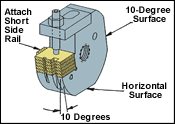Profile/Sharpen Multiple Form Tool Inserts Quickly
If you use carbide insert-type form tools on your screw machines and/or lathes, here’s a simple, relatively low cost way to profile and resharpen the inserts in multiples, getting the job done in a fraction of the time it would take to process them individually.
If you use carbide insert-type form tools on your screw machines and/or lathes, here's a simple, relatively low cost way to profile and resharpen the inserts in multiples, getting the job done in a fraction of the time it would take to process them individually. The process involves precisely locating and stacking the inserts on a toolholder (flat or circular), and then grinding or using a wire EDM to create them as a unit, producing an identical set.
To profile several blank inserts at the same time, the user loads the first insert in a blank toolholder and secures it with a side clamp. Next, the user installs a "step angle block" against the back of the insert. The user then loads four additional blank inserts in the holder, securing the assembly with a top clamp (see drawing). The step angle block ensures that the inserts will be a matched set. Once the inserts are secured by the top clamp, the side rail and side clamp can be removed for extra clearance. In the process of initially profiling the blank inserts, the (blank) toolholder on which they are mounted is also profiled.
After the inserts are profiled, the user loosens the top clamp, removes the step angle block and removes all but one of the inserts and retightens the top clamp. A short side rail and a side clamp (optional) are added on opposite sides of the insert for more rigidity, and the tool is ready for production.
In production, when the insert wears to the point that an adjustment must be made to keep parts within specs, the operator stops the machine, removes the dulled insert and replaces it with one of the backup inserts. Replacement is fast and easy, and because no adjustments to the machine or toolholder are necessary, the machine is quickly up and running again. The process is repeated as often as replacement inserts are available.
A worn set of inserts can be resharpened on a grinder equipped with a diamond wheel. The process, which takes about 5 minutes, consists of taking a thousandth of an inch off the tops of the inserts. The manufacturer offers a holder that secures the inserts for the resharpening operation. Worn inserts can be resharpened from four to seven times, depending on the job, and by regrinding them in sets, tool sharpening time can be reduced as much as 80 percent. Given the ease with which the inserts can be resharpened, replacements can always be ready at the machine, so that it is never necessary to idle a machine while a tool is being sharpened.
Flat form tool assemblies, consisting of a flat toolholder, top clamp, short rail, side clamp and assembly screws, come in a range of sizes. Blank, carbide, form tool inserts, step angle blocks (matched to the width of the toolholder) and tall side rails are also available.
Standard circular form tool assemblies for Brown & Sharpe machines consist of a toolholder, top and side clamps, short side rail, a shim for clamping the insert and assembly screws. Semi-standard circular form tools are also available for most of the popular cam-operated multispindle screw machines.
According to the manufacturer, Razorform Tools (Playa del Rey, California), the precisely matched inserts permit fast insert changes with no resetting of the toolholder, creating more uptime on production machines. Perhaps more importantly, the precisely matched inserts make tool changing a more predictable process. "Typically, when to change tools is a judgment call made by an operator who is watching several machines at the same time and trying to get as many cuts as possible before having to shut down a machine to change tools," explains John Gardner, Razorform's owner. "The Razorform system provides form tool inserts that perform identically, which means a user can expect predictable performance and predictable life. Inserts can be changed at specific intervals, taking the variability of operator judgment out of the equation and reducing the danger of making scrap parts.
Read Next
A Tooling Workshop Worth a Visit
Marubeni Citizen-Cincom’s tooling and accessory workshop offers a chance to learn more about ancillary devices that can boost machining efficiency and capability.
Read MoreDo You Have Single Points of Failure?
Plans need to be in place before a catastrophic event occurs.
Read MoreSeeing Automated Workpiece Measurement in Real Time
User-friendly inspection software for CNC machining centers was shown at IMTS 2024 monitoring measurements between and after machining while performing SPC based on recorded measurement values.
Read More
















.jpg;maxWidth=300;quality=90)



